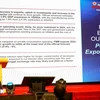The plan put forward by the Government for the equitisation of 432 State-owned enterprises (SOEs) in the 2014-2015 period has received concerns that such a huge job in a short time could result in low efficiency of equitisation.
Nhan Dan (People) online newspaper talked with Deputy Head of the Steering Committee for Business Renovation and Development, Pham Viet Muon, about the issue.
*After a conference on SOE restructuring in the 2014-2015 period, held in Hanoi on February 18, many people are worried that the equitisation of 216 SOEs each year, maybe even more, is valuing quantity over quality when it comes to the equitisation process. What do you think about this?
Looking back over the SOEs equitisation process since 1990, particularly in the 2001 - 2010 period, you can see clearly that the target for equitisation in the next two years is not too high.
In the 2001 - 2010 period, nearly 4,000 enterprises were equitised, an average of 400 enterprises each year. In the years between 2004 and 2006 we saw the highest number of equitised enterprises, with 700 to 800 each year. 216 enterprises in 2014 and then 2015 is not beyond our capacity.
183 enterprises (accounting for 43%) of the total 432 enterprises belong to ministries and corporations such as the Ministry of Culture, Sports and Tourism, the Vietnam National Shipping Lines and the Vietnam National Coal and Mineral Industries Group, which are located in big cities such as Ho Chi Minh City, Hanoi and Hai Phong. The socio-economic conditions, infrastructure and living standards are better in these cities, plus they receive greater attention from investors, which are all important factors for efficient equitisation.
Moreover, before 2010, these cities led SOE restructuring. Many of the mechanisms and policies being used now across the whole country were first used in these major urban hubs, so a strong foundation has already been laid in each.
*In addition to equitisation, the Prime Minister also ordered SOEs to speed up the divestment from their non-core businesses. To achieve this, the Government allowed SOEs to sell ineffective investments at lower than original prices. Do you think that this move will cause losses to the State capital?
The total capital to be divested from non-core businesses is estimated at 22 trillion VND. So far more than 4.2 trillion VND has been divested and the remaining 17 trillion VND is not a worrisome number since it only accounts for about 2% of the 840 trillion VND in charter capital of SOEs.
Currently the 17 trillion VND is primarily locked in the banking, insurance, property and securities sectors.
Investment is not always profitable, some projects are successful while others are ineffective and even cause huge losses. We must accept this as normal when doing business. The State allocates funds for enterprises and enterprises are obligated to preserve and grow such capital. But preservation and increase of capital should not be based on separate investments and projects.
Factual data shows that in general SOEs have been successful in preserving and growing State capital. Over the past three years, State capital rose at an annual average of 15%. In 2012, State capital at enterprises reached over 1 trillion VND, up 25% compared with a year earlier. In specific cases, collectives and individuals will be punished if they violate the law and cause losses to State funds. We are transparent and serious about this.
*According to the roadmap, SOEs will have to complete the divestment by the end of 2015. However, some have proposed that the deadline be extended for projects which are effective. What do you think about the proposal?
No one can say for sure that an investment will be as effective as expected. Some investments should be sold as soon as possible in order to preserve the capital. In a market economy, we should let the authorised fund managers do their duties. In addition, if we now can only sell an investment at a price of about 60-70% of the original value and then invest that money in a project that will bring twice the profits compared with the previous investment, then this is a beneficial divestment.
It is an impossible mission to force enterprises to regain 100% of the original value. Forcing enterprises to do impossible tasks is not only impractical but also causes losses for the State. Fund managers have nothing to lose, except for responsibility and their current jobs. So I think the Government should allow SOEs to sell their non-core investments below the original prices in specific cases where we can expect benefits.
For effective projects, the divestment should still be completed before the end of 2015 in line with the SOE restructuring roadmap.-VNA
Nhan Dan (People) online newspaper talked with Deputy Head of the Steering Committee for Business Renovation and Development, Pham Viet Muon, about the issue.
*After a conference on SOE restructuring in the 2014-2015 period, held in Hanoi on February 18, many people are worried that the equitisation of 216 SOEs each year, maybe even more, is valuing quantity over quality when it comes to the equitisation process. What do you think about this?
Looking back over the SOEs equitisation process since 1990, particularly in the 2001 - 2010 period, you can see clearly that the target for equitisation in the next two years is not too high.
In the 2001 - 2010 period, nearly 4,000 enterprises were equitised, an average of 400 enterprises each year. In the years between 2004 and 2006 we saw the highest number of equitised enterprises, with 700 to 800 each year. 216 enterprises in 2014 and then 2015 is not beyond our capacity.
183 enterprises (accounting for 43%) of the total 432 enterprises belong to ministries and corporations such as the Ministry of Culture, Sports and Tourism, the Vietnam National Shipping Lines and the Vietnam National Coal and Mineral Industries Group, which are located in big cities such as Ho Chi Minh City, Hanoi and Hai Phong. The socio-economic conditions, infrastructure and living standards are better in these cities, plus they receive greater attention from investors, which are all important factors for efficient equitisation.
Moreover, before 2010, these cities led SOE restructuring. Many of the mechanisms and policies being used now across the whole country were first used in these major urban hubs, so a strong foundation has already been laid in each.
*In addition to equitisation, the Prime Minister also ordered SOEs to speed up the divestment from their non-core businesses. To achieve this, the Government allowed SOEs to sell ineffective investments at lower than original prices. Do you think that this move will cause losses to the State capital?
The total capital to be divested from non-core businesses is estimated at 22 trillion VND. So far more than 4.2 trillion VND has been divested and the remaining 17 trillion VND is not a worrisome number since it only accounts for about 2% of the 840 trillion VND in charter capital of SOEs.
Currently the 17 trillion VND is primarily locked in the banking, insurance, property and securities sectors.
Investment is not always profitable, some projects are successful while others are ineffective and even cause huge losses. We must accept this as normal when doing business. The State allocates funds for enterprises and enterprises are obligated to preserve and grow such capital. But preservation and increase of capital should not be based on separate investments and projects.
Factual data shows that in general SOEs have been successful in preserving and growing State capital. Over the past three years, State capital rose at an annual average of 15%. In 2012, State capital at enterprises reached over 1 trillion VND, up 25% compared with a year earlier. In specific cases, collectives and individuals will be punished if they violate the law and cause losses to State funds. We are transparent and serious about this.
*According to the roadmap, SOEs will have to complete the divestment by the end of 2015. However, some have proposed that the deadline be extended for projects which are effective. What do you think about the proposal?
No one can say for sure that an investment will be as effective as expected. Some investments should be sold as soon as possible in order to preserve the capital. In a market economy, we should let the authorised fund managers do their duties. In addition, if we now can only sell an investment at a price of about 60-70% of the original value and then invest that money in a project that will bring twice the profits compared with the previous investment, then this is a beneficial divestment.
It is an impossible mission to force enterprises to regain 100% of the original value. Forcing enterprises to do impossible tasks is not only impractical but also causes losses for the State. Fund managers have nothing to lose, except for responsibility and their current jobs. So I think the Government should allow SOEs to sell their non-core investments below the original prices in specific cases where we can expect benefits.
For effective projects, the divestment should still be completed before the end of 2015 in line with the SOE restructuring roadmap.-VNA



















